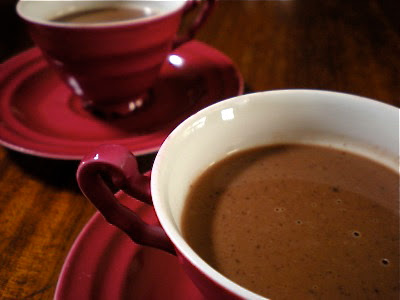It makes sense, then, that German chocolate cookies would be just as revolutionary. And even easier to eat.

The origin of this iconic pairing isn't as obvious as it seems: Ask a real German, and you'll be met with cries of "Was ist das?" (believe me, it happened yesterday when I was hanging out with a few). German chocolate is actually the creation of the U.S.-based Samuel German, who produced a baking chocolate sweeter than semisweet in 1852- forseeing the hunger of legions of prediabetic Americans, no doubt.
I'm never one to turn my nose up at sugar, but I do like my chocolate on the dark side. So, inspired by this recipe from Taste and Tell, I used a bittersweet type (71% cocoa) for my cookies. I wouldn't dream of telling an American what to do, however, so feel free to replace it with an equal amount of German or semisweet chocolate.
An accompanying glass of iced mint tea is the only real requirement.
German Chocolate Cookies
Makes: 2 1/2 dozen.
6 tablespoons all-purpose flour
1/2 teaspoon baking powder
1/4 teaspoon salt
8 ounces bittersweet chocolate, coarsely chopped
5 tablespoons unsalted butter
3 large eggs
1 cup plus 1 tablespoon firmly packed brown sugar
1 1/2 teaspoons vanilla extract
1/2 cup semisweet chocolate chips
1/3 cup shredded coconut (unsweetened)
1/3 cup finely chopped pecans
1. In small bowl, sift together flour, baking powder and salt. In small pot, over very low heat, melt chocolate and butter until smooth, stirring constantly. Set aside to cool.
2. With electric mixer, beat eggs and brown sugar on high speed until mixture is pale and thick, about 5 minutes. Add cooled chocolate mixture and vanilla and beat until just combined. Scrape down the bowl and beat again for 10 seconds. Add flour mixture and mix on low until just combined. Do not overmix. Fold in chocolate chips. (Dough will look very liquid, but it will harden in the refrigerator.) Chill at least 6 hours or overnight.
3. Heat oven to 375°. Line baking sheets with parchment paper. In small bowl, stir together coconut and pecans. Quickly roll tablespoons of dough into a ball, then coat with coconut-pecan mixture. Place about 1 inch apart on baking sheets, flattening balls slightly. Bake for 11 to 13 minutes, rotating pans halfway through, until tops of cookies are set and begin to show a few cracks. Let cool 3 minutes on sheets before removing to racks to cool completely.
Makes: 2 1/2 dozen.
6 tablespoons all-purpose flour
1/2 teaspoon baking powder
1/4 teaspoon salt
8 ounces bittersweet chocolate, coarsely chopped
5 tablespoons unsalted butter
3 large eggs
1 cup plus 1 tablespoon firmly packed brown sugar
1 1/2 teaspoons vanilla extract
1/2 cup semisweet chocolate chips
1/3 cup shredded coconut (unsweetened)
1/3 cup finely chopped pecans
1. In small bowl, sift together flour, baking powder and salt. In small pot, over very low heat, melt chocolate and butter until smooth, stirring constantly. Set aside to cool.
2. With electric mixer, beat eggs and brown sugar on high speed until mixture is pale and thick, about 5 minutes. Add cooled chocolate mixture and vanilla and beat until just combined. Scrape down the bowl and beat again for 10 seconds. Add flour mixture and mix on low until just combined. Do not overmix. Fold in chocolate chips. (Dough will look very liquid, but it will harden in the refrigerator.) Chill at least 6 hours or overnight.
3. Heat oven to 375°. Line baking sheets with parchment paper. In small bowl, stir together coconut and pecans. Quickly roll tablespoons of dough into a ball, then coat with coconut-pecan mixture. Place about 1 inch apart on baking sheets, flattening balls slightly. Bake for 11 to 13 minutes, rotating pans halfway through, until tops of cookies are set and begin to show a few cracks. Let cool 3 minutes on sheets before removing to racks to cool completely.
I don't think I can convey how difficult it was to not inhale these while I was taking pictures. The toasty, full flavors of shredded coconut and chopped pecans are like edible precious jewels adorning the soft, rich chocolate inside. Overall, these cookies are less sweet- due to the higher cocoa percentage and unsweetened coconut- than a traditional German chocolate cake, but I'd argue that they're even better. In cookies, like women, sometimes it's best to trade sweetness for a little depth.























